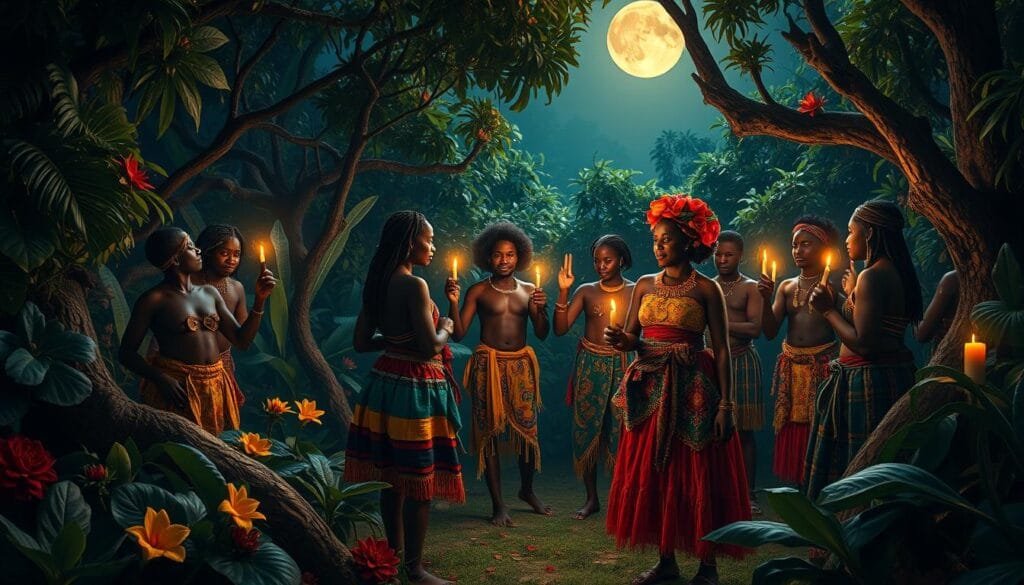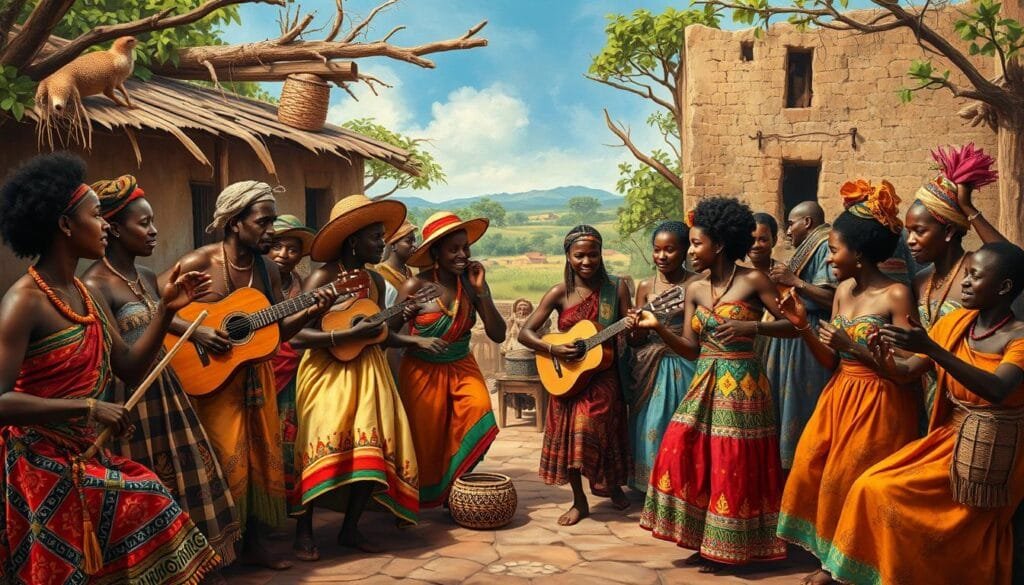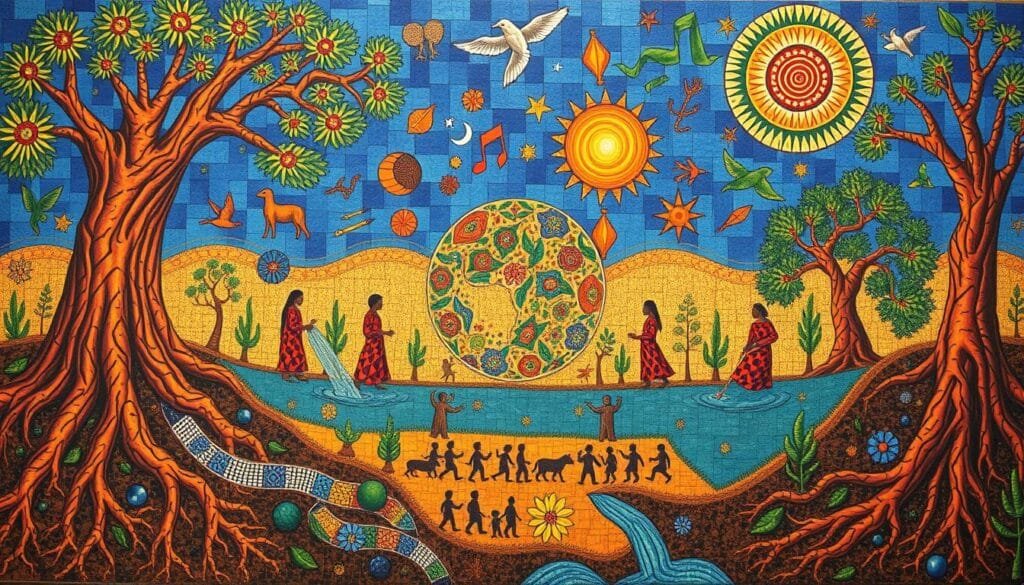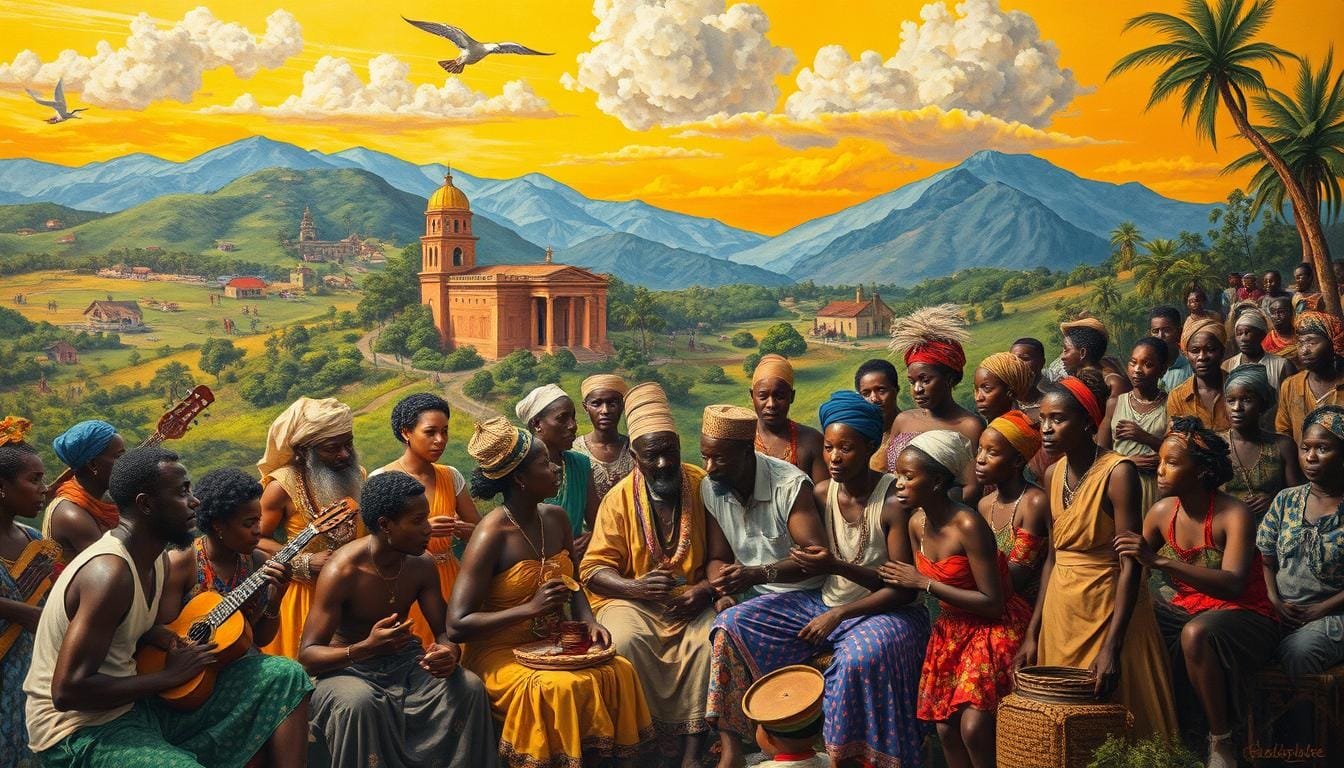The history of the Americas is deeply marked by the formation of slave societies. It’s a story of Africans brought by force, yet resilient. They faced harsh conditions but held onto their cultural identities. They mixed their traditions with slavery conditions to create a new, supportive culture. This blend influenced many American cultural aspects. On this journey, African traditions in family, religion, and music were kept alive.
Historically, the trans-Atlantic slave trade moved about 12 million Africans. Sadly, 10 to 15 percent died during the harsh Middle Passage. Yet, British North America got only six percent of these people. Still, the impact of slavery on culture is deep. African-American heritage, shaped by struggle, enriches language, food, and architecture today.
Key Takeaways
- The formation of slave societies resulted from the resilience of African people who merged their traditions with their new reality.
- Approximately 12 million Africans were transported via the trans-Atlantic slave trade, with significant cultural impacts.
- Despite suppression, African cultural practices influenced American society in various domains, including religion, music, and cuisine.
- British North America received only six percent of the captives, yet the cultural impact of slavery in the region remains extensive.
- Preservation of African-American heritage plays a crucial role in understanding the cultural impact of slavery in the Americas.
The Origins of Slave Culture
Slave culture has deep roots in African traditions. These traditions came with slaves to the New World. The journey began in the 16th century, with the first African slaves arriving in Puerto Rico in 1513. The Danish West India Company’s arrival in St. Thomas, St. John, and St. Croix spread African cultural influences.
African Roots and Traditions
African cultural traditions are diverse, covering languages, cooking methods, and music. The first African slaves reached the continental United States in 1526. This was at the San Miguel de Gualdape settlement in South Carolina. They kept their culture alive despite many challenges.
For example, words like “gumbo” and “jazz” became part of American speech. These reflect the deep merging of cultures. Culinary skills, such as deep-fat frying, became key in Southern food. African music influenced spirituals with its call-and-response style. The preservation of these elements shows the slaves’ strength and flexibility.
Adaptation and Resistance
Slaves didn’t just adapt to survive; they also resisted. They kept their ways of expressing themselves and staying independent. They reshaped African tales and parables, giving them new meanings that matched their lives in the New World. These weren’t just stories but lessons in resilience and wit.
Studies show slaves resisted through their culture. They kept African spiritual and medical practices as silent protests. This defiance was rooted in their hope to return to their homeland someday. It strengthened their identity and willpower over 400 years since the first Africans arrived in Virginia in 1619.
The size of the plantations affected slave societies deeply. Bigger plantations had different slave cultures compared to smaller farms or city homes. Each had its own customs and ways to resist. The complex interplay of adapting and resisting shaped a lasting slave culture.
The Role of Religion in Slave Societies
Religion was a key part of life in slave societies. It helped people deal with their tough daily lives. It provided hope, spiritual power, and a way to resist. Slaves mixed their African beliefs with new religious practices, creating unique adaptations.

Syncretic Religions
Syncretic beliefs were a standout feature of slave religion. Slaves combined African religions with Christianity and Islam. This mix helped them handle their hard situations.
It also kept their cultural identity alive and built a strong community feeling. The slave trade’s continuation in places like Cuba and Brazil kept African religions vibrant there. Muslims taken to Brazil enriched the religious culture. Secret meetings showed that suppressed beliefs could survive through community support.
Millennial Beliefs
Millennial beliefs were also vital in slave religion. Slaves saw their suffering as tests, hoping for a future of freedom and equality. This hope had a big impact, especially on those who embraced Christianity in the 1800s and sought freedom based on their faith.
Baptist and Methodist churches were popular among slaves for their lively worship and genuine emotion. They offered slaves a feeling of control, comfort, and a shared identity. Spirituals and hidden worship sessions strengthened the bonds and resilience of enslaved communities.
| Aspect | Details |
|---|---|
| Formation of Syncretic Beliefs | Blend of African traditions with Christianity and Islam |
| Influence of Islam | Prominent in regions like northeast Brazil through the 19th century |
| Evangelical Sects | Transformation led by Baptists, Methodists, and Moravians in the 18th century |
| Suffering as Spiritual Test | Millennial beliefs envisioning a future of freedom and equality |
| Secret Religious Meetings | Held several nights a week, affirming communal and spiritual bonds |
Cultural Contributions of Slaves to American Society
The cultural inputs from enslaved Africans have deeply affected America since the 1600s. They’ve shaped language, music, dance, and food, showing the strength and adaptability of Africans.
Language and Communication
Enslaved Africans brought a mix of languages and dialects that changed the way Americans talk. This mix created new dialects, influencing American English today. You can see African linguistic influences in regional accents and everyday speech, highlighting a strong African impact on American culture.
Music and Dance
Music and dance stand out as major African contributions to American culture. The beat of drums and the melody of the banjo have enriched music genres like jazz, blues, gospel, and hip-hop. African rhythms turned into dance moves that are key to America’s cultural scene.

Cuisine and Cooking Practices
America’s food scene greatly benefits from African culinary traditions. Merging African ingredients with New World foods led to dishes like gumbo, jambalaya, and soul food. These recipes showcase African, Native American, and European culinary influences, underlining African impact on American food.
| Statistical Data | Detail |
|---|---|
| Virginia 1620 Census | 32 Africans recorded, serving various planters |
| Massachusetts 1641 | First law to legalize slavery in the region |
| Mid-18th Century Virginia | Enslaved population constituted 50% of total population |
| Mid-18th Century South Carolina | Enslaved population constituted 60% of total population |
| New England Enslaved Population | Less than 5%, but up to 20% in cities like Newport |
| Royal African Company Expansion 1672 | Increase in African transport to colonies |
| 1660s Legal Developments | Establishment of lifelong servitude laws in Virginia, Maryland, New York, etc. |
How Slave Traditions Preserved Identity
Slaves kept their cultural identities alive despite harsh suppression. They secretly held onto their African roots—like language, stories, and religious practices. This kept their culture alive. It helped them stay connected to their heritage and stand out from their oppressors.
Throughout history, enslaved societies showed they could keep their cultures alive. Music and dance were key in keeping their identities. Folktales and oral histories helped them remember their past, as seen in Margaret Walker’s Jubilee (1966).

Food traditions were also crucial. Recipes passed down generations reflected African tastes, keeping their identity alive. Despite the Transatlantic Slave Trade, African foodways survived and evolved in the Americas.
Slave communities also embraced festivals and group activities. For example, the Three Kings Day Festival in Havana and Carnival merged African and European cultures. These occasions offered comfort, fun, and a stronger sense of community and identity among slaves.
The table below compares the preservation of cultural traditions among key slave societies in history:
| Society | Key Traditions Preserved | Period |
|---|---|---|
| Mesopotamian and Sumerian Civilizations | Religious practices, oral histories | 6000-2000 BCE |
| Roman Empire | Craftsmanship, language | 27 BCE – 476 CE |
| British Population (Domesday Book) | Feudal customs, serfdom records | 1086 CE |
| American Slaves (Colonial Era) | Music and dance, folktales | 1619 onwards |
At its core, maintaining traditions helped enslaved people keep their identities. Through music, cooking, or stories, they made sure their heritage stayed vibrant, even in harsh conditions.
How was Slave Culture and Slave Societies Established
The formation of slave societies in the Americas was a harsh process. It forced many different African ethnic groups to come together. Despite the harsh conditions they faced, their strong cultural spirit helped create unique cultural identities.
Enslaved people made up a big part of the population in the antebellum South. By 1860, nearly half of the 4 million enslaved lived in cotton states. They kept their identities by blending their traditions with their new surroundings. This mix of cultures helped establish a strong slave culture.
Stories and folklore shared religious and cultural beliefs. These tales mixed African traditions with New World elements. Craftspeople passed on stories through objects like canoes and ceramics. The mix of languages from different cultures led to new languages, like pidgin and creole.
Enslaved communities also created new musical forms. They used drums, rattles, and other instruments to make music that was truly their own. This music sometimes carried secret messages. It combined church music with African rhythms, adding depth to their cultural expression.
Slave culture was born out of a tough yet creative struggle. African traditions and European influences blended under slavery. This has given us a deep understanding of cultural resilience and identity, even today.
| Key Statistics | Details |
|---|---|
| Enslaved Population by 1860 | Nearly 4 million |
| Proportion in Cotton-Producing States | Over half |
| Traditional Folklore | Blended African and New World influences |
| Musical Instruments | Drums, rattles, banjars, fiddles |
| African Slaves in Transatlantic Trade | Around 12 million |
| British Ships Transport | About 3.4 million Africans |
| Deaths on Atlantic Crossing | 450,000 |
Slave Markets and the Spread of Slave Culture
From the 16th to the 19th century, the transatlantic slave trade forcefully moved about 12.5 million Africans to the Americas. This dark trade spread slave culture across continents. Early European settlements and trade routes played a big role in this.
Early European Settlements
European settlements in the New World spread culture through slavery. Countries like Spain, Portugal, and England needed enslaved Africans to build their colonies. Most enslaved Africans were sent to South America and the Caribbean.
Only a small fraction went directly to British North America. Enslaved people brought their cultures, including languages and music. By 1850, a unique African American culture had developed in the United States.
Trade Routes and Interactions
European powers set up trade routes, moving enslaved Africans and fostering cultural exchanges. Portugal, Spain, England, and France played major roles in this. From 1625 to 1867, over 5.8 million Africans were trafficked by Portugal and Brazil. British ships carried over two million Africans between 1726 and 1800.
In places like Jamaica, African and European cultures mixed, creating unique cultural landscapes. Despite high death rates, new Africans kept arriving, refreshing African cultural elements in the colonies.
| Region | Number of Enslaved Africans | Mortality Rate | Cultural Impact |
|---|---|---|---|
| Caribbean | Over 10 million | High – up to 5% natural decrease | Melange of African and European cultures |
| Brazil | 5.8 million | High due to poor conditions | Strong African cultural retention |
| British North America | 0.75 million | Lower due to natural increase | Development of African American culture |
The slave trade left a mixed legacy, blending tragedy with cultural richness. Enslaved Africans significantly influenced New World societies, despite their forceful displacement.
Conclusion
The journey to understand slave culture shows how strong and adaptable enslaved Africans were. Even with 12.5 million Africans displaced forever, slavery deeply affected cultures. The Transatlantic Slave Trade, led by Europe, forced millions across the sea. Only 10.7 million survived the journey. British ships alone carried more than two million Africans between 1726 and 1800.
Knowing the history of these events helps us see African slaves’ big contributions to America’s culture. This knowledge makes American history richer, showing how African traditions mixed into society. It’s crucial to see how African slaves kept their identities and traditions alive. They did this despite the harshness of chattel slavery.
This in-depth look at slave societies and their cultures reveals how slavery’s legacy affects us today. From language to music, and food, slavery’s influence is clear. The story of adaptation and strength helps us understand slave culture better. By acknowledging this history, we honor the enduring spirit of those who suffered. Yet, they still left a lasting mark on our world.
FAQ
How did slave societies form in America?
Slave societies in America started with the forceful bringing together of various African ethnic groups. These peoples blended their rich traditions with the harsh life of slavery. This created a new, mixed culture.
What were some key elements of African roots and traditions retained by slaves in America?
Slaves kept African roots alive through language, cooking, and music. Words like “gumbo” and “jazz,” cooking methods like frying, and music styles like call and response stayed in use.
How did slaves adapt and resist oppression?
Slaves kept their culture alive, practicing their traditions in secret. They shared African stories that taught lessons of hope and cleverness. Despite harsh conditions, they maintained their identity and community spirit.
What is the role of syncretic religions in slave societies?
In slave societies, blended religions were vital. They mixed African beliefs with New World faiths. This helped slaves face oppression, stay connected, and hope for freedom.
How did millennial beliefs manifest in slave cultures?
Millennial beliefs in slave cultures saw hardship as a test from the spiritual realm. Slaves believed enduring these trials led to eventual freedom. Their faith integrated hopes for liberation.
What contributions did African slaves make to American language and communication?
African slaves enriched American language with words like “gumbo” and “jazz.” They also brought African dialects and instruments, influencing how Americans communicated and made music.
In what ways did African slaves shape American music and dance?
African slaves introduced rhythms and musical styles from their homeland into American culture. Call and response, African instruments, and new dance moves have deeply influenced American arts.
What are some examples of African culinary practices influencing American cuisine?
African cooking methods and spices greatly impacted American food. Techniques like deep-fat frying and using certain herbs have defined dishes like gumbo, adding rich flavors.
How did slave traditions help in preserving cultural identity?
By keeping their languages, stories, and customs alive, slaves preserved their unique culture. This helped them remember who they were and remain strong in spirit.
How were slave markets and European trade routes instrumental in spreading slave culture?
Slave markets and trade routes spread slave culture by moving enslaved people across regions. This allowed diverse cultural exchanges among colonies and within slave communities.
